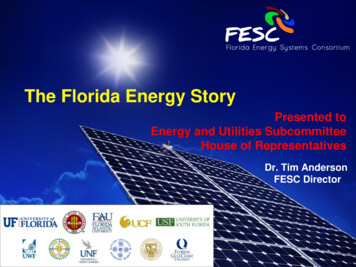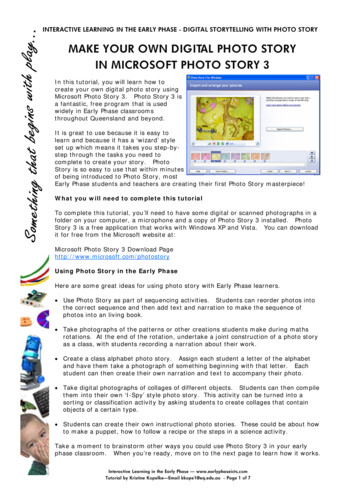
Transcription
The Florida Energy StoryPresented toEnergy and Utilities SubcommitteeHouse of RepresentativesDr. Tim AndersonFESC Director
Florida Energy Systems ConsortiumCreated by Florida Statute to share energy relatedexpertise and promote collaboration among theenergy experts at its 11 public universities.GoalUniting Florida’sUniversities to become aleader in energy research,education, technology, andenergy systems analysis.VisionFlorida Universitiesinnovating for sustainableenergy generation,distribution, and usagesystems.
Strategic Research Thrusts Overarching - UnderstandingFlorida’s Energy Systems Developing Florida's Biomass Resources Harnessing Florida's Solar Resources Ensuring Nuclear Energy & Carbon ConstrainedTechnologies for Electric Power in Florida Exploiting Florida’s Ocean Energy Resources Securing our Energy Storage and DeliveryInfrastructure Enhancing Energy Efficiency & Conservation3
Integrated PV/Battery/Lighting ModuleObjectives Integrating a transparentorganic PV device, lithium ionbatteries and organic lightemitting device into a solarpowered lighting panel Development of both organicPV cells and organic LEDswith transparent electrodes Development of highvolumetric energy densitylithium batteriesF. So, S. Meng and J. Xue, UF4
Assessment of Greenhouse Gas Emissionsfor Selected Renewable FuelsProf. Mark Brown, Dept. Env. Eng. Sci. - UFTotal annual GHG emissions predicted: various scenariosof policy, technology, and social/behavioral changesEmployment generation from biofuel productionto meet Florida’s needs in 2020Value added resulting from biofuel productionto meet Florida’s needs in 2020RFS Renewable Fuel Standards
Strategic Research Thrusts Overarching - Understanding Florida’s Energy Systems Developing Florida's Biomass Resources Production of liquid fuels & other chemical intermediates(cellulosic ethanol, biodiesel) & gaseous fuels & feedstocks (gasification, anaerobic digestion), efficientconversion of biofuels to electric power (SOFCs,turbines), energy intensive crops, solid waste as abiomass resource Harnessing Florida's Solar Resources Ensuring Nuclear Energy & Carbon ConstrainedTechnologies for Electric Power in Florida Exploiting Florida’s Ocean Energy Resources Securing our Energy Storage and Delivery Infrastructure Enhancing Energy Efficiency & Conservation6
Developing Florida Biomass Resources Florida has 10% of USbiomass resources, 7% wood Transportation costs high– 75 mile limit Biomass to Energy Options15 million acres of forest land10 million acres of farm land # 1 in sugarcane and citrus # 1 in forestresidues # 1 in urban wood waste # 2 in vegetable (waste)– Burn to produce steam– Convert to chemicals Biologically , thermally, extraction7
Biomass Challenges and Opportunities Reduce costs of biomass growth, harvesting,and processing– Increase crop yield, automated harvesting, optimalplant distribution, more efficient conversion efficiency Ensure sustainable implementation– Water quality, waste processing, fuel for food Full scale plant not demonstrated– Uncertainty increases cost of financing Florida could be leader in bio-energy– Large resource, significant investment in R&D, targetis to become the center for knowledge-based industry8
Bio-Energy Research Focus Areas Energy Intensive Crop Development – molecular genetics Energy From Algae: Fresh water, marine algae; Genetictransformation; Solar photo-bioreactors; Lipids to fuels Thermo-Chemical Conversion of Biomass to Liquid Fuels Biochemical Conversion Biomass to Liquid Fuels & Chemicals Integrated Biofuel, Hydrogen, and Electricity Cogenerationfrom Biomass and Solid Waste
Strategic Research Thrusts Overarching - Understanding Florida’s Energy Systems Developing Florida's Biomass Resources Harnessing Florida's Solar Resources Photovoltaics, solar concentrators (fuel production,gasification), outreach and education in broad solartechnologies Ensuring Nuclear Energy & Carbon ConstrainedTechnologies for Electric Power in Florida Exploiting Florida’s Ocean Energy Resources Securing our Energy Storage and Delivery Infrastructure Enhancing Energy Efficiency & Conservation10
PV Challenges for Florida The levelized cost of PV is more expensive than fossilfuels ( 0.17/kWhr)1– Cost declining steadily (22% decreasewith doubling on production)– Grid parity expected in Florida in 20152 Production intermittency makes gridintegration difficult at high penetration Florida has not been competitive inattracting industry.– Important factors: secure market for PVinstallations, low manufacturing costs, ices.htm;500 kWp flatroof mounted system, grid connected, sunny climate2www1.eere.energy.gov/solar/pdfs/dpw lushetsky.pdf11
Florida Potential– Very high solar radiation ( 25% capacity factor withunobstructed 1D tracking at FPL DeSoto Plant)– Large coastal population/available interior land in southern halfof State, thus minimizing average transmission distance.– High per capita residential electricity use with potential forsignificant distributed deployment (increase resilience tocatastrophic events, reduce transmission need).– PV electricity production well matched to demand.– Our current cost of electricity is relatively high ( 12 /kWhrresidential), thus making PV more attractive.– PV manufacturing in nearby regions (SE US, Caribbean,South and Central America) is minimal - represents an exportpotential.12
Where Will the PV Hubs be Located?The opportunity for Florida is to become an exporter ofPV systems to the Southeast US, Caribbean, Americas,and beyond, and thus create direct and indirect jobsrelated to manufacturing, assembly, design, & research.World’s fastest growingindustry ( 32%/yr)7.2GWp of new PV capacitywas installed in 2009 ( 38.5billion in global revenues)1.Estimated annual productionrate of 250GWp at10% PV penetration.1http://www.epia.org/fileadmin/EPIA docs/public/Global Market Outlook for Photovoltaics until 2014.pdf13
Harnessing Florida’s Solar Resources A broad spectrum of solar projects covering––––––––––Solar Resource Mapping and Test FacilitySolar Thermal Power for Bulk GenerationPV Manufacturing Pilot LineDevelopment of Low Cost Solar CellsPlug n Gen PV Power SystemBeyond Photovoltaics – Rectenna DevelopmentHigh temperature Thermo-chemical Hydrogen ProductionSolar Technologies for Clean WaterSolar PV Charging StationZero Energy Homes (Solar Decathalon) Florida SUS Has National Profile in Solar Extensive Industry Collaborations Significant External Funding
Solar FuelsStrategies Use readily availablesmall molecules Use every light photon Combine processes tomake cheaper (processintensification)15
PV Thin Film Pilot Line at USF Large area thin film deposition,flexible roll- to-roll to 13.5” width. Physical vapor deposition of metaland transparent contacts. Deposition of CIGS noveldeposition and growth pathways. Evaluation of novel depositiontools, inks, on-line metrology tools.16
New Test Stand at FSEC
Flexible polymer solar modules by roll-to-rollprinting (Dr. Franky So)14”x14” polymer solar modules have been printed. 12 cells are connected.Collaborators:Materials: John Reynolds, University of FloridaRoll-to-roll printing: Frederik Krebs, RISO, Denmark
Strategic Research Thrusts Overarching - Understanding Florida’s Energy Systems Developing Florida's Biomass Resources Harnessing Florida's Solar Resources Ensuring Nuclear Energy & Carbon ConstrainedTechnologies for Electric Power in Florida Exploiting Florida’s Ocean Energy Resources Securing our Energy Storage and DeliveryInfrastructure - Transmission & distribution, gridreliability and resiliency, continuous energy delivery,integrated renewable systems, customer ownedmicrogrids, power quality, energy storage, locationaware systems, and efficiency Enhancing Energy Efficiency & Conservation19
Electrical Energy Storage Grid Level Storage– Pumped hydroelectric storage ( 100/kWh)– Compressed air energy storage (cost effective)– Batteries: Flooded lead-acid, valve regulated lead-acid,NaS and lithium-ion (new), flow batteries Power Quality Control– Flywheels, Superconducting magnets, Supercapacitors20
FRCC Region
Demand Response in Florida Florida peak demand – 50 GW (2010), 62.5 GW in2019 Peak reduction estimates by 2014:– BAU 5% or 2.5 GW– EBAU 9% or 4.5 GW– Achievable participation 13% or 6.5 GW By 2019, the achievable participation could be18% or more than 11 GW Key drivers: very central AC penetration and directload control programs These represent very large avoided capital costsSource: FERC, A NATIONAL ASSESSMENT OFDEMAND RESPONSE POTENTIAL, 2009
Energy Storage & Delivery Infrastructure Smart Grids / Micro GridsAdvanced energy storage systemsEnergy security and integrityPolicy and economics––––––Requirements validationPerformance assessmentRisk management and mitigationEnvironmental impactInvestment and insurance driversPublic needs assessment, Economic necessity, Market pull Issues System design––––Hardware / software design & integration testingSensor, communication and control technologiesOperational concepts developmentReduced design cycle time
Strategic Research Thrusts Overarching - Understanding Florida’s Energy Systems Developing Florida's Biomass Resources Harnessing Florida's Solar Resources Ensuring Nuclear Energy & CarbonConstrained Technologies for ElectricPower in Florida - Nuclear and electric powerworkforce training, partnerships with industry incritical research needs, power systems, powerelectronics & conditioning, carbon sequestration Exploiting Florida’s Ocean Energy Resources Securing our Energy Storage and Delivery Infrastructure Enhancing Energy Efficiency & Conservation24
UF Nuclear Training Reactor Design, license, & construct fully digital controlsystem– Partners: Progress Energy, Siemens, DoE, AREVA,Canberra, FESC Working on Licensing Amendment Request(LAR) to pave path for future Establish certificate on digital control andinstrumentation in NRE Dept. Training courses with statecolleges (C. FL, Indian River,and N. FL), utilities, andgovernment (e.g. NRC)25
Carbon Capture and Sequestration ProjectsGeological Sequestration: CedarKeys/Lawson Formation (deepsaline aquiferOptimize: Transportation,Energy Consumption, andLand UseTotal Soil Organic Carbon Stock2.26 giga tonFL CO2 Production0.26 giga ton/yr26
Strategic Research Thrusts Overarching - Understanding Florida’s EnergySystems Developing Florida's Biomass Resources Harnessing Florida's Solar Resources Ensuring Nuclear Energy & Carbon ConstrainedTechnologies for Electric Power in Florida Exploiting Florida’s Ocean EnergyResources – Ocean and thermal differential energyharvesting Securing our Energy Storage and DeliveryInfrastructure Enhancing Energy Efficiency & Conservation27
Exploiting Florida’s Marine Energy Resources Harness ocean currents & thermal gradients Develop, fabricate & deploy 20 kWunderwater turbineVerdant PowerDeliverables 10-year program potential is as much as 5 GWof capacity generated from the Gulf Stream andup to 2 GW of equivalent cold-water-based AC Estimated 10,000 engineering / tech. jobs New high-tech Florida-based sectorhttp://oceancurrents.rsmas.miami.edu/28
Off-shore Wind Energy Energy potential offshore Florida’sAtlantic coast estimated as 10.3 GW Comprehensive analysis of Florida’s offshore windresources needed Wind energy industry already in Florida NextEra Energy is largest U.S. wind developer GE manufactures wind turbine generators (Pensacola) Siemens, NA Wind Power headquarters (Orlando) Florida has wide, shallow continentalshelf (cheaper if 30 m).29
Strategic Research Thrusts Overarching - Understanding Florida’s Energy Systems Developing Florida's Biomass Resources Harnessing Florida's Solar Resources Ensuring Nuclear Energy & Carbon ConstrainedTechnologies for Electric Power in Florida Exploiting Florida’s Ocean Energy Resources Securing our Energy Storage and Delivery Infrastructure Enhancing Energy Efficiency &Conservation - Improvement of existing & newbuilding efficiency, industry energy auditing & efficiency,outreach & education.30
Enhancing Energy Efficiency & Conservation Residences consume more than 40% of Florida’selectricity 2008 Florida Energy Act calls for new homes to use only50% of 2007 code minimum within 10 years Home retrofits must also be addressed – existing stockoutnumbers new homes by 50 to 1. Demonstration homes at multiple campuses - UCF, UF,FSU, USF, FIU, UWF: Used for research, training,outreach. 2400 at 0.12/kWh 1800 at 0.12/kWhEfficiency First34Flexible Residential Test Facility31
Program Development Provide exploratory research fundingInform faculty about funding opportunitiesFacilitate proposal team formationFacilitate proposal developmentMore than 100 funding opportunities from variousagencies distributed to faculty. Competitive Contracts & Grants: 10/1/09-9/30/10531 Applications with 581M total request374 awards in the amount: 84M32
Large Proposal Efforts PV Manufacturing Initiative, 25M – UF Energy Efficient Building Systems RegionalInnovation Cluster Initiative, 129.7 M – UCF SolarFuel Hub, 122M – USF Nuclear Hub (NEMSI), 122M – U of Utah
Key Activities – Tech Commercialization Two Tiered Model–––––Early vetting of technologies for path to marketProven model for spawning long-term collaborative R&DEngage industry in development process in the universityProvides 2X leveraging of FESC funds on each projectNatural pipeline of technology deployment to private sector Early Stage Market Research / Business Plans –Funded 15 business plans / market studies. –Completed. OTL matching technoligies. Matching Funds R&D Program – Up to 50k / projectfor 5 later stage projects with a 2:1 industry match –Funded 6 projects. Industry contracts being executed.
Education – Focus on Workforce Development Four Focus Areas– Community College Training AS/BS Degree Programs Certificate Program Professional Development– Nuclear Engineering Education– Built Environment Education– Masters Level Education Close integration with Outreach and Industrial CollaborationProgram implementation with Florida Advanced Technological EducationCenter (FLATE). Mission elements:– Create State-wide technician educationaldelivery system– Provide curriculum development, best practicedemonstrations, student involvement andoutreach activities necessary to meet theworkforce capacity in target sectors35
Outreach – Focus on Energy Efficiency Targets the general public & builtenvironment Utilizes Florida’s extension educationsystem and FESC partners Collaborates with the home buildersand construction industry Create an online compendium ofcurrent, accurate publications Develop / conduct technical & continuing education programs Produce public service pieces (NPR, PBS, public access ) Partner with utilities to implement performance-based demand sidemanagement programs Work with “green” certification (FGBC, USGBC, GBI )36
TOWARD DEVELOPING A STRATEGIC PLAN ONENERGY FOR THE STATE OF FLORIDA Solar (PV andThermal) Bio-Energy Grid Technologies &Electricity Distribution Ocean Energy Nuclear Education Secure EnergySystems Energy Efficiency andConservation,Geothermal Energy Storage Carbon Capture Wind Energy Policy
Messages FESC is doing very well– Your support is making a difference – thank you The Consortium is a key State resource foreconomic development– Improving climate for attracting energy industry Better prepared workforce Accessible research enterprise– Energy represents opportunity for economic growth Particularly in bioenergy, solar, and smart grid– Systems approach connecting research tocommercial product38
Web Site: www.FloridaEnergy.ufl.edu39
Renewable Energy Research Portal (FSU) http://energyportal.cci.fsu.edu/40
Why Florida Should Lead in Sustainable EnergyIt has the most to lose if we don’t
Energy From Algae: Fresh water, marine algae; Genetic transformation; Solar photo-bioreactors; Lipids to fuels Thermo-Chemical Conversion of Biomass to Liquid Fuels Biochemical Conversion Biomass to Liquid Fuels & Chemicals Integrated Biofuel, Hydrogen, and Electricity Cogeneration from Biomass and Solid Waste











